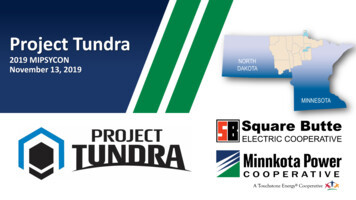
Transcription
Project Tundra2019 MIPSYCONNovember 13, 20191
What is Project Tundra?Project Tundra is a bold initiative tobuild the world's largest carboncapture facility in North Dakota2
Agenda Why CO2 captureProject summaryHow to capture CO2Plant impactResourcesCurrent status3
Who We Are Minnkota Power is a wholesale electricgeneration and transmission cooperative Headquartered in Grand Forks, N.D. 11 member-owner cooperatives 3 in ND, 8 in MN 12 municipals – Northern Municipal PowerAgency Serve 35,000 square miles in 33 counties About 150,000 consumers 390 employees4
Generation Resources5
Typical Joint System ResourcesOther 3%Other 3%Wind 19%Wind 34%Coal 55%Coal 67%WAPA 8%WAPA 11%CapacityEnergy6
Why Carbon Capture? Demand for carbon-free energy Carbon-managed future Intermittency of renewable generationrequires backup Natural gasNuclearHydroCoalBatteries? North Dakota coal facilities advantages Nearby Williston-Basin oil formation Unique geology7
Why Minnkota? Resource planning Young Station with Tundra – lowest cost of reliable electricityCombined Cycle – similar cost, but subject to variable gas pricesSimple Cycle – good for back-up, but too expensive for 24/7 powerWind – competitive with combined cycle, but not reliable in extreme cold Carbon managed future Young 2 with Tundra – 0.11 tons CO2/MWhCombined Cycle – 0.35 tons CO2/MWhSimple Cycle – 0.54 tons CO2/MWhUltra Supercritical Lignite – 0.96 tons CO2/MWh8
Carbon IntensityCO2 Intensity in lbs per MWh *2500Best firmcapacityresource isYoung stationwith Tundra20001500Also thelowest cost10005000Resource TypeYoung 1&2 - TodayUlta SC -LigniteSimple-Cycle GasCombined-Cycle GasYoung 2 TundraYoung 1&2 Tundra9
Why Minnkota? North Dakota jobs Young Station with Tundra – 400 with mine Combined Cycle– 25 Environmentally friendly enhanced oil recovery (EOR) Pipeline & oilfield jobs Even California recognizes as “green” oil North Dakota Geology Internationally recognized as excellent storage capacity DOE has funded two phases of storage study and analysis DOE will now consider providing partial funding to development of storagefacility10
Project Tundra Summary Retrofit Milton R. Young Unit 2 Capture approximately 90 percent of the CO2 Permanent storage CO2 injected into deep saline formationsbeneath the nearby coal mine Enhanced Oil Recovery CO2 transported 100 mile pipeline CO2 substantially increase production indeclining fields 45 year history1111
Permanent StorageProject1212
EOROil Field TargetProject TundraOil Field TargetProject TundraYoung Station13
14
Petra Nova Project Texas project that ProjectTundra is modeled after Operational in December 2016 On time and on budget 1,300% increase in oil production Enhanced oil recovery only Pipeline & oilfield all part ofthe project15
Project attributes(with comparison to Petra Nova)TundraPetra Nova455 MWe240 MWeFlue gas fuelLignitePRBSteam sourceExtract from hostStand-alone CCGTHost plant ownerCoop – long-term viewIPP – short term viewCO2 dispositionOn-site storage or sold to EORProject-owned EOR oilfieldNoneYes – highRevenue sources45Q Tax Credits & CO2 salesCrude oil salesHost unit dispatchTo serve long-term contractsDay-to-day decisionFluorMitsubishiSizeFinancial exposure to oil priceCapture technology provider1616
How Does Carbon Capture Work? All amine based systems verysimilar Quencher – Cools flue gas prior toentering Absorber Tower, removeadditional SO2 emissions Absorber Tower – Lean amine mixedwith flue gas, captures CO2 insolution (rich amine) Regenerator – Rich amine is strippedof CO2, amine returns to absorber,CO2 is “pure” for compression. Lots of heat exchangers17
Process Requirements 100% Flue Gas Capture – 90% CO2 Recovery 11,000 to 12,000 tons/day of CO2 captured60-85 MW of auxiliary powerLarge consumer of low pressure steamIncrease plant CW needs by 60% Options for BOP steam and power Natural Gas Cogeneration Unit (Petra Nova) Integrate existing plant Natural gas pas package boilers (steam only)18
Plant Impact - Natural Gas Boilers One pre-FEED study looked at natural gas boilers FeasiblePreserve project economicsPossible additional CO2 sourceNo impact to existing turbine NG challenges Lack of natural gas infrastructurePermitting of new emissions sourceCommingling gas streamsIncrease capital cost19
Plant Impact – Steam Integration LP steam supplied from IP/LP crossover 35-50% of crossover steam flow extracted Lower capital cost Integration challenges Low crossover pressureIncreased expansion over HP and IP bladesLow LP flow during reduced load casesSteam conditioning controlCondensate return locationLoss of unit capacity20
Heat Recovery Optimization Significant loss in energy production due to steamintegration Possible cycle optimization Replace existing steam drive boiler feedwater pumps Condensate heat recovery Heat recovery from CO2 compressor intercoolers Heat recovery from flue gas cooling Back-pressure Steam Turbine21
Heat Recovery Optimization All options were un-economical over facility ITC life cycle Replace steam driven boiler feedwater pump Did not raise crossover pressure enough Heat recovery from CO2 Compressor Intercoolers Small increase in plant power output, but too costly Heat Recovery from Flue Gas Cooling Small increase in plant power output, but too costly, & possible AQCSissues Back-pressure Steam Turbine Costly and space constraints22
Water Resources Increase of plant cooling capacity by 60% Existing cooling system at thermal capacity Hot months – cooling water exceeds desired temperature Install new Cooling Tower Make-up from Process Condensate (Quencher) Increase river water take-off Cooling tower blowdown Possible deep well injection23
Our People are the Experts Initial research led by the Energy &Environmental Research Center (EERC)at the University of North Dakota Recognized as leading experts in carbon captureand utilization projects David Greeson Former Vice President of Development for NRGEnergy, Inc. Petra Nova was his vision and he led the projectfrom inception through design, financing,construction, and commissioning24
Cost Recovery 45Q Federal Income Tax Credits Start construction prior to end of 2023 12 year eligibility 50 per tonne of CO2 permanently stored underground 35 per tonne of CO2 used for enhanced oil recoveryRepresents approximately 2 billion to Project TundraMinnkota cannot monetize these credits We will need a partner25
Project ScheduleTundra Development IC GrantConstruction – complete in Q3 2024DOE GrantConstruction – complete in Q4 2025Form ProjectCoOutside Law FirmFinancial AdvisorLong ScheduleApply/receive permitsFEED StudyProject DocumentsStorage/EOR DealsFinancingLong ScheduleLong ScheduleLong ScheduleEarly Start Construction26
Next Steps Tax Guidance on 45Q Comments submitted Front-End Engineering & Design and Costing CO2 Capture System (Fluor Enterprises) Geologic Storage (EERC-CarbonSAFE) Pipeline/EOR Permitting (2020-2022) Longest schedule is permit for geologic storage facility CCS air and water permits to be initiated during the FEED Financial investment decision & commence constructionbefore the 2023 deadline for 45Q tax credits2727
Questions?28
16 Project attributes (with comparison to Petra Nova) Tundra Petra Nova Size 455 MWe 240 MWe Flue gas fuel Lignite PRB Steam source Extract from host Stand-alone CCGT Host plant owner Coop -long-term view IPP -short term view CO2 disposition On-site storage or sold to EOR Project-owned EOR oilfield Financial exposure to oil price None Yes -high Revenue sources 45Q Tax Credits & CO










